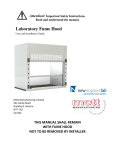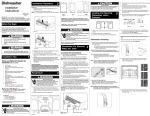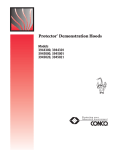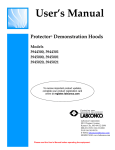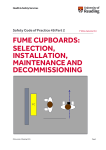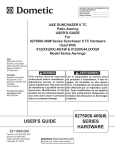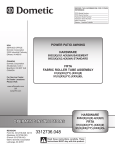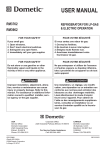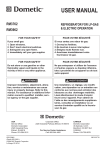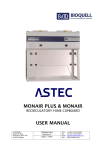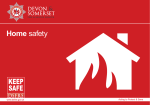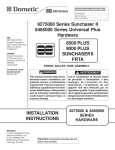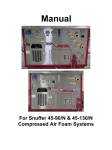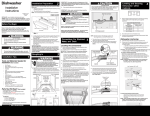Download Laboratory Fume Hood
Transcript
Attention! Important Safety Instructions. Read and understand the manual. Laboratory Fume Hood User and Installation Guide Mott Manufacturing Limited 452 Hardy Road Brantford, Ontario N3T 5L8 Canada THIS MANUAL SHALL REMAIN WITH FUME HOOD NOT TO BE REMOVED BY INSTALLER Table of Contents Safety First ....................................................................................................... Pg.3 Fume Hood Applications .................................................................................. Pg.3 Fume Hood Safety ............................................................................................ Pg.4 Fume Hood Alarms ........................................................................................... Pg.5 Safety Procedure ............................................................................................... Pg.6 Optional Accessories ........................................................................................ Pg.7 Exhaust System Requirements .......................................................................... Pg.7 Installation ........................................................................................................ Pg.8 Electrical Requirements .................................................................................... Pg.9 Routine Maintenance ...................................................................................... Pg.10 References ...................................................................................................... Pg.12 Project Specific Data ...................................................................................... Pg.13 Laboratory Fume Hood – User and Installation Guide Rev 9 Page 2 Safety First Your new fume hood has been designed and tested to ensure the highest level of protection available in the marketplace today. Our fume hoods are tested in the factory to very high levels of containment using the current ASHRAE 110 standard. They have been shown to meet or exceed the American National Standard for Laboratory Ventilation and the American Industrial Hygiene Association standard as outlined in ANSI/AIHA Z9.5-2003. Mott Manufacturing recommends that all fume hoods be tested after installation using the latest ASHRAE 110 tracer gas test. Results should be compared to the requirements outlined in the latest ANSI/AIHA Z9.5 standard as well as other guidelines which may be adopted by local authorities having jurisdiction. As with many laboratory activities, fume hood use must follow certain procedures to achieve the maximum operator protection. It is the fume hood operator’s responsibility to be familiar with and apply the principles outlined in this manual as well as procedures developed for your individual organization’s special needs. The safety requirements for radioisotope operations are beyond the scope of this guide. Qualified experts should be consulted to develop specialized procedures for the use of such hoods. Fume Hood Application In order to achieve the maximum operator protection, it is essential fume hoods are used only for the application they were designed for. Chemical fume hoods must not be used for biological work, chemical storage, spray painting or any operation incompatible with materials used in the hood construction. Hood Liners: Normally, fume hoods will be equipped with white fibreglass reinforced polyester liners. This is a general purpose liner with excellent resistance to a wide variety of reagents. Fibreglass lined hoods are not suitable for radioisotope or perchloric acid work. Other liners are sometimes used such as stainless steel and PVC. PVC hoods have excellent resistance to acids, but poor resistance to organic solvents. Stainless steel is impervious to organics, but should not be used for acid work. If you are uncertain about the suitability of your fume hood for a particular use, contact Mott Manufacturing. Laboratory Fume Hood – User and Installation Guide Rev 9 Page 3 Fume Hood Safety Test your fume hood containment before first use and at least once per year thereafter. Verify the exhaust system is operating before each use. Verify operation of the fume hood alarm before each use. This may be done by temporarily blocking the air sampling port to simulate loss of airflow. Close the sash as much as possible when working at the fume hood - use the glass as a face shield. Hoods equipped with a combination vertical and horizontal sash are intended to be used primarily with the vertical frame down and the horizontal moving panels open. Never raise the sash vertically without closing the horizontal panels first. Close the sash completely when not working at the fume hood. Avoid placing your head inside the fume hood. Avoid rapid movements in front of and inside the fume hood. This can cause air current to draw contaminants out of the fume hood. Avoid raising the sash(s) too quickly. Raise the sash at a moderate rate and allow the air velocity to increase or the variable air volume system to react to the door movement. Never work with sashes set higher than the established working height. Contact safety or air balancing staff if the safe working height is unknown. Never work with both sashes open on a walk-in hood. The lower sash is for setup access only. Turn on the lights. Good illumination will reduce eyestrain. Set up apparatus as close to the back as possible. In no case should apparatus be closer than 6 inches (15 cm) from the door. Don’t block airflow. Raise large objects 2 inches (5 cm) off the counter by placing them on blocks. This allows airflow underneath and prevents stagnant areas. Never store large quantities of chemicals in the fume hood. Chemical containers block airflow and create unnecessary hazards. Use cabinets designed to store chemicals instead. Clean up chemical spills as soon as possible. Avoid damage to countertops and buildup of large quantities of vapors. All electrical equipment connected to fume hood receptacles must be certified or approved and in good condition including electrical ground if applicable. Avoid excessive heat within the fume hood. Special hood configurations are available for high heat situations. Baffles should be adjusted by qualified air flow experts or safety officers only. Laboratory Fume Hood – User and Installation Guide Rev 9 Page 4 Perchloric acid hoods should have the wash down system operated at least once per day until a thorough cleaning is accomplished. 5-15 min will probably be sufficient depending upon flow rates achieved by the in-duct portion of the system. Never allow the area immediately in front of a fume hood in use to become a traffic area. Others walking by the hood face will adversely affect containment. When inserting and removing arms and objects into the fume hood, ensure that movement is parallel with the airflow direction. Avoid any scooping type motions. Avoid rapid removal of objects or arms from hood. Avoid filling the hood with excessive equipment or materials. As a rule, no more than 50% of the available work surface should be covered with materials or equipment. Fume Hood Alarms Your fume hood must be equipped with a suitable low flow alarm*. The low flow alarm is designed to protect the user from exposing themselves to hazards by alarming when low face velocity is detected. Do not mute the alarm or otherwise defeat its operation. Such alarms may be factory supplied or purchased separately. When the alarm sounds immediately close the sash and step away from the hood. If the alarm does not reset itself, evacuate the area and contact facilities. There may be a malfunction in the exhaust system serving that hood. Under certain circumstances, it may be necessary to raise the sash above the established working height to allow materials and apparatus to enter the hood. In this case, wait two minutes after all hazard generating activity has ceased and all containers of materials are tightly closed. The sash may then be raised as high as needed for setup operations. During this time only, it is safe to temporarily mute the alarm by pressing the enter button. Calibration: Generally, low flow alarms must be calibrated in the field after the fume hood exhaust system has been adjusted or balanced. This service is not included with the purchase of the hood and it is recommended that this be performed by a firm specializing in air balancing or ventilation systems. * NFPA 45, 2000: Fire Protection for Laboratories using Chemicals. “6.8.7.1 A measuring device for hood airflow shall be provided on each laboratory hood. 6.8.7.2 The measuring device for hood airflow shall be a permanently installed device and shall provide constant indication to the hood user of adequate or inadequate hood airflow” Laboratory Fume Hood – User and Installation Guide Rev 9 Page 5 Safety Procedures Written procedures should be developed by your safety officer or committee to handle a variety of emergencies such as: Fire Explosions Out of control experiments Power Failures Blower Failure These procedures will vary to suit your facility’s needs. All laboratory workers should be familiarized with these safety procedures and regular drills should be carried out to ensure all staff knows what to do in the event of a real emergency. Particular attention should be placed on the development of known escape routes. Such escape routes should not require personnel to cross in front of a fume hood. See BS7258 for more information (References, Pg 13) Laboratory Fume Hood – User and Installation Guide Rev 9 Page 6 Optional Accessories A number of optional accessories are available to enhance fume hood function or safety. Contact your Mott Manufacturing representative for more information. Automatic fire extinguisher: Know as a “snuffer” it is located on the roof of the fume hood and will release its charge of chemical fire suppressant when a fire occurs within the fume hood. Variable Air Volume (VAV) system: Such a system will reduce the amount of temperate air lost to the outside by varying the exhaust volume from the fume hood automatically based on the position of the door. Air flow monitoring devices (alarms): These are available to alert the user that there is insufficient airflow for proper containment. Distillation racks: Fiberglass or aluminum rods and clamps can be attached to the back wall of the hood to assist in setting up apparatus. Magnehelic gauge: This is to monitor the pressure drop across in-duct filters that may be installed above the fume hood. Exhaust System Requirements Exhaust Volume: Mott Manufacturing’s line of fume hoods is designed to provide good containment with a face velocity range of 80 to 120 feet per minute. Certain models may be operated safely as low as 60 fpm. Different sash positions require more or less exhaust volume. Contact Mott Manufacturing if in doubt. Ducting and Blower: Exhaust systems should be designed and installed in accordance with the latest ANSI/AIHA Z9.5 American National Standard for Laboratory Ventilation. One important aspect of that standard is the need to ensure that the blower is located outside the laboratory building. Blowers located within the laboratory create ducting under positive pressure which results in potential leakage back into the laboratory. In addition, the blower itself may have holes around the shaft or belt. Makeup Air: Make-up air for these fume hoods shall be provided in accordance with the latest edition of ANSI/AIHA Z9.5 with a terminal throw velocity of one half of the hood face velocity. Laboratory Fume Hood – User and Installation Guide Rev 9 Page 7 Installation It is anticipated that fume hood installation will be carried out by personnel experienced in such work, therefore, only brief instructions are presented here. These instructions are general in nature. Special fume hoods or job sites will require different procedures. Contact Mott Manufacturing if in doubt about the best way to proceed. Bench Hoods: 1. Ensure that base cabinets and fume hood work surface is installed, fastened down and level. Plumbing, electrical and duct work should be roughed-in by qualified trades people. 2. Unwrap / uncrate fume hood. Remove Outer side panels by pulling out from the top of the side panel as close to the front post as possible to release the concealed clips. Unbolt the fume hood from the shipping skid. 3. Counterweight: Cable and pulley type sash: with rollers on weight facing back of hood insert the sash cable loop between the two tabs on the weight. Slide the clevis pin through the holes away from the back. Insert and spread the cotter pin. Check that the cable is not twisted and rides properly over all pulleys. Before leaving job site, the cable must be thoroughly lubricated with lithium based grease. It is preferable to do this after all dust generating work is complete to avoid debris sticking to grease. Chain and sprocket type sash: Chain is pre-lubricated. Two bolts are installed though the counterweight for shipping. These bolts must be removed. Before proceeding, ensure that sash operates properly and that the chain has not slipped off sprockets during shipment. 4. Hood must be lifted onto the work surface by the corners only. Leather gloves will be required. Lifting hood by airfoil may cause damage. Using mechanical means to raise the shipping skid to work top height will ease the job. 5. After fume hood is properly positioned on the work surface, check the squareness and adjust as necessary. Once satisfied with the position of the hood on the work top, caulk the joint with high quality silicone. In areas where there are seismic concerns, consult local authorities or engineers for additional anchorage requirements 6. Perform final plumbing, electrical and Ducting connections. Screws holding the light fixture to the hood roof are for shipping. Remove to facilitate future re-lamping. All final connections shall be made by qualified trades people in accordance with applicable electrical and plumbing codes. Since factory pre-piping may be damaged in shipping or during installation, all pipe connections including those made at the factory must be pressure tested in accordance with local codes. Laboratory Fume Hood – User and Installation Guide Rev 9 Page 8 Floor Mounted Floor Mounted installation is similar to bench hoods except that there is usually no work top to be concerned with. Such hoods are generally set directly on the floor. Electrical Requirements Electrical safety may be compromised and protection impaired if the requirements outlined are not respected. Electrical Supply: 120V/60hz/5A maximum for lighting circuit. For other electrical requirements, see hood data plate. Voltage mains supply fluctuations shall not exceed 10 percent. Electrical supply shall be permanently connected to supplied junction box(s). Equipment must be grounded at the supplied grounding connection. (see below - typical). This equipment must be provided with a dedicated circuit breaker or switch as part of the building installation in close proximity, labeled and within easy reach of the user. Care must be taken that the disconnect remains accessible to the user and is not obscured by equipment location. Circuit breaker(s) may be 15A, 20A or 30A depending on hood model. Requirement on hood data plate must be respected. Ground connections are labeled with the following symbol: Electrical supply wire requirements: Breaker Size 15A 20A 30A Minimum wire gauge 14 AWG 12 AWG 10 AWG Laboratory Fume Hood – User and Installation Guide Rev 9 Page 9 Ambient Conditions: Pollution Degree 2 Installation Category II Altitude 3000m ASL maximum Operating Temperature range: 5C to 40C Maximum relative humidity 80% up to 31C decreasing linearly to 50% at 40C Certified for indoor use only Convenience receptacles: Standard NEMA Receptacles are provided for certified customer supplied appliances. The maximum total rating for all receptacles is marked on the fume hood data plate. Routine Maintenance and Inspections The fume hood is only one part of a much more complicated safety system. Periodic maintenance and testing should be performed on all aspects of the ducting, blowers and exhaust system. Seek professional guidance from the company responsible for the installation and maintenance of the entire system. Your fume hood is virtually maintenance free and requires only a minimum amount of maintenance. These maintenance procedures can be applied to standard bench hoods as well as walking, radioisotope and perchloric acid types. PERIODIC CLEANING OF THE FUME HOOD A fume hood that is clean and orderly is safer and easier to “shut down” in an emergency, in addition to being more attractive in appearance. The exterior surface of the fume hood, as well as the glass sash, should be wiped down regularly as required with an appropriate cleaner. (Note: be sure this cleaner is compatible with other chemicals within the laboratory). Stainless steel surfaces should be cleaned with a stainless steel cleaner. Wipe only in the direction of the grain to ensure scratches do not form. Detailed information about stainless steel care is available in Mott’s “Stainless Steel Care and Cleaning” manual. FLUORESCENT LIGHT REPLACEMENT Replacement bulbs or fixtures should be the same type as installed in the factory. Fixtures must be changed by a qualified electrician. Equivalent fixtures of alternate manufacture may be substituted. Laboratory Fume Hood – User and Installation Guide Rev 9 Page 10 To replace the fluorescent bulbs: Using a step ladder, reach the fluorescent light fixture from the top of the fume hood. Tilt the fixture away from you and rest it against the duct stub. Turn both light bulbs to align the pins in the end of the bulb with the slots in the light fixture ends. Remove light bulbs. Be sure not to break light bulbs against fume hood structure. Dispose of bulbs safely. Insert new lights into fixture, rotate 90 degrees. Tilt fixture back toward you, position on top of light fixture support angles. If Fume Hood has top enclosure panels, it will be necessary to remove the front panel by unscrewing it from the side panels. Proceed as above. Reinstall top enclosure panels. VISUALLY CHECK THE CONDITION OF INTERNAL PULLEYS AND SASH CABLES Check all internal pulleys and cables for any deterioration on a yearly basis. If the Fume Hood environment is very corrosive or the hood is subjected to intensive use, check more frequently. It is recommended to lubricate the cable yearly or as needed with lithium grease. If replacement cables or pulleys are needed they may be ordered by specifying the fume hood model number. After installation, no routine adjustment of cables should be needed. The sash cables can be inspected by accessing the top of the Fume Hood using a step ladder. Check for any corroded or frayed cables and replace. Also, check the connection between the cable and the door handle at the bottom of the door. Laboratory Fume Hood – User and Installation Guide Rev 9 Page 11 Additional References National Research Council. Prudent Practices in the Laboratory -Handling and Disposal of Chemicals. National Academy Press: Washington, D.C. 1995. American Society of Heating, Refrigeration and Air-conditioning Engineers, Inc. Standard 1101995 Method of Testing Performance of Laboratory Fume Hoods. American Society of Heating, Refrigeration and Air-conditioning Engineers, Inc. Atlanta Georgia 1995. American Industrial Hygiene Association. Standard ANSI/AIHA Z9.5-2003 American National Standard for Laboratory Ventilation. American Industrial Hygiene Association, Fairfax Virginia 2003. British Standards International. BS 7258: Part 2: 1994. Laboratory Fume Cupboards: Recommendations for the exchange of information and recommendations for installation National Fire Protection Association. NFPA 45. Standard on Fire Protection Using Chemicals. G. Thomas Saunders. Laboratory Fume Hoods, A User’s Manual. John Wiley & Sons, Inc. New York, NY 1993. Scientific Equipment and Furniture Association. Recommended Practices. www.sefalabs.com. Laboratory Fume Hood – User and Installation Guide Rev 9 SEFA 1. Laboratory Fume Hoods: Page 12 Project Specific Data In this section, Owners may wish to record information such as electrical fixture model numbers, replacement light bulbs, etc. for future reference. Laboratory Fume Hood – User and Installation Guide Rev 9 Page 13













